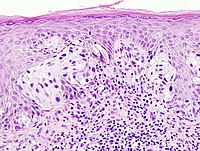Surgical pathologyis the most significant and time-consuming area of practice for mostanatomical pathologists.Surgical pathology involves gross and microscopic examination ofsurgicalspecimens, as well asbiopsiessubmitted by surgeons and non-surgeonssuch asgeneral internists,medical subspecialists,dermatologists,andinterventional radiologists.


The practice of surgical pathology allows for definitive diagnosis of disease (or lack thereof) in any case where tissue is surgically removed from a patient. This is usually performed by a combination of gross (i.e., macroscopic) andhistologic(i.e., microscopic) examination of the tissue, and may involve evaluations of molecular properties of the tissue byimmunohistochemistryor other laboratory tests.
Specimens
editThere are two major types of specimens submitted for surgical pathology analysis:biopsiesandsurgical resections.[1]
Abiopsyis a small piece of tissue removed primarily for the purposes of surgical pathology analysis, most often in order to render a definitivediagnosis.Types of biopsies includecore biopsies,which are obtained through the use of large-bore needles, sometimes under the guidance of radiological techniques such asultrasound,CT scan,ormagnetic resonance imaging.Core biopsies, which preserve tissue architecture, should not be confused withfine-needle aspirationspecimens, which are analyzed usingcytopathologytechniques.Incisional biopsiesare obtained through diagnostic surgical procedures that remove part of a suspicious lesion, whereasexcisional biopsiesremove the entire lesion and are similar to therapeuticsurgical resections.Excisional biopsies of skin lesions and gastrointestinal polyps are very common. The pathologist's interpretation of a biopsy is critical to establishing the diagnosis of abenignormalignanttumor, and can differentiate between different types and grades ofcancer,as well as determining the activity of specific molecular pathways in the tumor. This information is important for estimating the patient'sprognosisand for choosing the best treatment to administer. Biopsies are also used to diagnose diseases other than cancer, includinginflammatory,infectious,oridiopathicdiseases of theskinandgastrointestinal tract,to name only a few.
Surgical resectionspecimens are obtained by the therapeutic surgical removal of an entire diseased area or organ (and occasionally multiple organs). These procedures are often intended as definitive surgical treatment of a disease in which the diagnosis is already known or strongly suspected. However, pathological analysis of these specimens is critically important in confirming the previous diagnosis,stagingthe extent of malignant disease, establishing whether or not the entire diseased area was removed (a process called "determination of thesurgical margin",often usingfrozen section), identifying the presence of unsuspected concurrent diseases, and providing information for postoperative treatment, such asadjuvant chemotherapyin the case of cancer.
In the determination of surgical margin of a surgical resection, one can use thebread loafingtechnique, orCCPDMA.A special type of CCPDMA is named after a general surgeon, or theMohs surgerymethod.
Workflow
edit- Gross examination
- Frozen section
- Fixation & Embedding
- Histopathologic examination
- Ancillary testing
- The surgical pathology report
- Direct consultation
Subspecialties
editMany pathologists seek fellowship-level training, or otherwise pursue expertise in a focused area of surgical pathology. Subspecialization is particularly prevalent in the academic setting, where pathologists may specialise in an area of diagnostic surgical pathology that is relevant to their research, but is becoming increasingly prevalent in private practice as well. Subspecialization has a number of benefits, such as allowing for increased experience and skill at interpreting challenging cases, as well as development of a closer working relationship between the pathologist and clinicians within a subspecialty area. Commonly recognized subspecialties of surgical pathology include the following:
- Bone pathology
- Cardiac pathology
- Cytopathology(A board-certifiable subspecialty in the U.S.)
- Dermatopathology(A board-certifiable subspecialty in the U.S.)
- Endocrine pathology
- Gastrointestinal pathology
- Genitourinary pathology
- Gynecologic pathology
- Head and Neck pathology
- Hematopathology(A board-certifiable subspecialty in the U.S.)
- Neuropathology(A board-certifiable subspecialty in the U.S. and a recognised specialty in the U.K.)
- Ophthalmic pathology
- Pediatric pathology(A board-certifiable subspecialty in the U.S. and a recognised specialty in the U.K.)
- Pulmonary pathology
- Renal pathology
- Soft tissue pathology
- Breast pathology
See also
editNotes and references
edit- ^Grizzle WE, Bell WC, Young ES, Billings PE (Apr 2008)."The Efficient Operation of the Surgical Pathology Gross Room".Biotechnic & Histochemistry.83(2). Biotech Histochem:71–82.doi:10.1080/10520290802127610.PMC2903959.PMID18568681.
Bibliography
edit- Richard Cote, Saul Suster, Lawrence Weiss, Noel Weidner (2003).Modern Surgical Pathology (2 Volume Set).London: W B Saunders.ISBN0-7216-7253-1.
{{cite book}}:CS1 maint: multiple names: authors list (link)